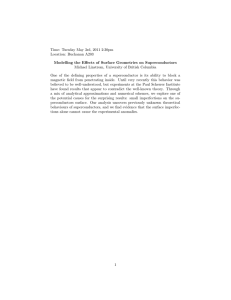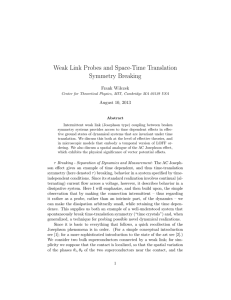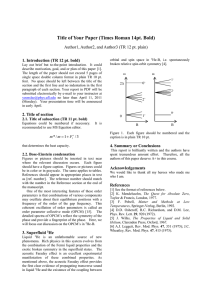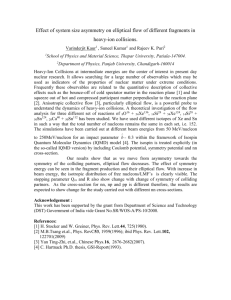Superfluidity and Space-Time Translation Symmetry Breaking Please share
advertisement
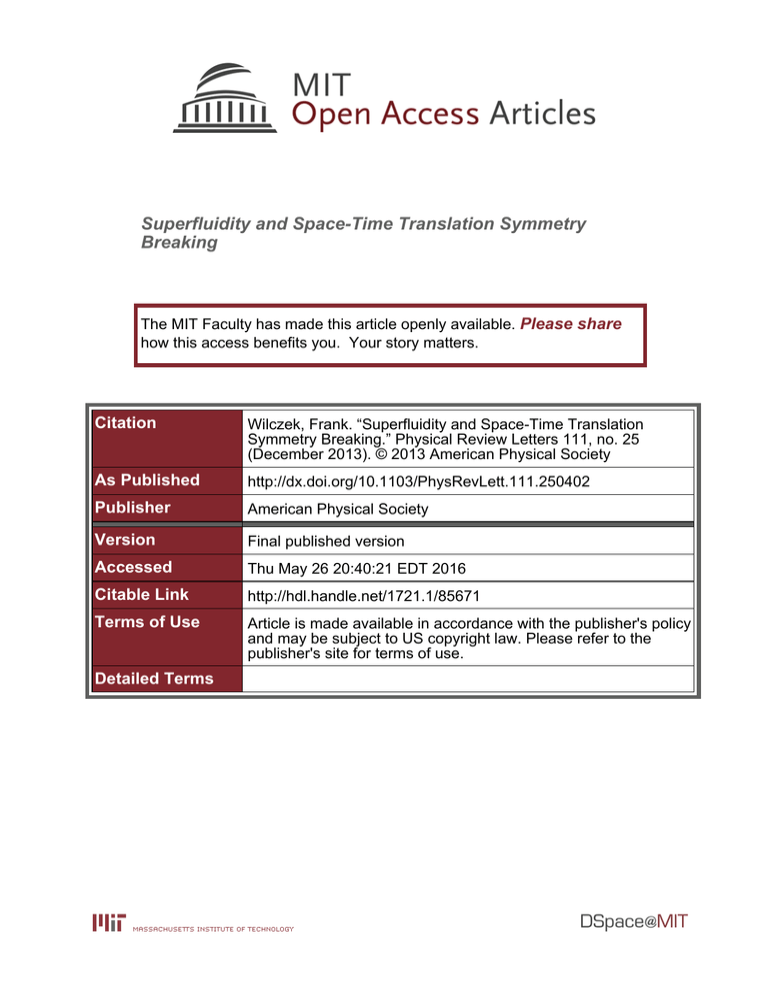
Superfluidity and Space-Time Translation Symmetry Breaking The MIT Faculty has made this article openly available. Please share how this access benefits you. Your story matters. Citation Wilczek, Frank. “Superfluidity and Space-Time Translation Symmetry Breaking.” Physical Review Letters 111, no. 25 (December 2013). © 2013 American Physical Society As Published http://dx.doi.org/10.1103/PhysRevLett.111.250402 Publisher American Physical Society Version Final published version Accessed Thu May 26 20:40:21 EDT 2016 Citable Link http://hdl.handle.net/1721.1/85671 Terms of Use Article is made available in accordance with the publisher's policy and may be subject to US copyright law. Please refer to the publisher's site for terms of use. Detailed Terms week ending 20 DECEMBER 2013 PHYSICAL REVIEW LETTERS PRL 111, 250402 (2013) Superfluidity and Space-Time Translation Symmetry Breaking Frank Wilczek Center for Theoretical Physics, MIT, Cambridge, Massachusetts 02139, USA (Received 2 October 2013; published 18 December 2013) I present a simple model that exhibits a temporal analogue of superconducting crystalline (LarkinOvchinnikov-Ferrell-Fulde) ordering, with a time-dependent order parameter. I sketch designs for minimally dissipative ac circuits, all based on time translation symmetry () invariant dynamics, exploiting weak links (Josephson effects). These systems violate spontaneously. I also discuss effective theories of that phenomenon, and space-time generalizations. DOI: 10.1103/PhysRevLett.111.250402 PACS numbers: 11.30.j, 67.10.j, 74.20.Fg Recently there has been considerable interest in the possibility of spontaneous breaking of time translation symmetry [1–5]. Here I bring in ideas from superfluidity which both establish connections with central ideas of that field and widen the experimental possibilities significantly. Microscopic model.—The energy functional 4 2 1 2e ~ 2e ~ ~ ~ ELOFF / (1) @ A @ A 4 @ 2 @ describes superconductors with wavelike or crystalline (Larkin-Ovchinnikov-Ferrell-Fulde [6,7], or ‘‘LOFF’’) condensates. In the absence of a vector potential we will have, upon minimizing the energy in Eq. (1), ~ ¼ k~ x~ þ 0 ðxÞ (2) for some wave vector k~ with k2 ¼ . Several possible realizations of LOFF states have been identified [8–12]. It is natural to consider the possibility of a temporal analogue to the spatial behavior indicated in Eq. (2). What we want, is that the pairing occurs between states separated by a characteristic frequency. For superconducting systems the absolute frequency dependence is rendered ambiguous by the possibility of time-dependent gauge transformations, or stated more simply by the lack of a natural zero of energy, so it is simplest to use the language of particlehole pairing. For orientation purposes, let us begin by further specializing to the transparent case of two flat bands with energies "1 < "2 , and the Hamiltonian "2 þ "1 N þ ð"2 "1 ÞS3 gðS Sþ þ Sþ S Þ 2 " þ "1 ¼ 2 N þ ð"2 "1 ÞS3 2gðS~2 S23 Þ; 2 H¼ (3) where X X N ¼ byk bk þ ayk ak k (4) Sþ ¼ k X 1 X y S3 ¼ bk bk ayk ak ; 2 k k 0031-9007=13=111(25)=250402(4) (5) define Hermitian pseudospin operators S1 , S2 , S3 that satisfy the algebra of angular momentum and generate isospinlike rotations between the a and b modes. Since N, S~2 , and S3 commute, we can construct the minimum energy states for H, given N, by maximizing S (so S ¼ N=2) and choosing a state with definite S3 . If S3 is also allowed to vary, the minimum will occur for " "1 N ; : hS3 i ¼ max 2 (6) 4g 2 (The second alternative on the right-hand side, which saturates the population of the a modes, is essentially trivial.) On the other hand it can be appropriate to hold the expectation value of S3 fixed. We can imagine, for example, that the a and b modes correspond to states in distinct layers, whose total occupations can be fixed independently. (Note that the assumed interaction term does not require interlayer tunneling—this is just another way of saying that it commutes with S3 .) As we can see by rearranging ayk bk byl al ! ayk al byl bk (7) the assumed interaction corresponds, roughly, to an effective repulsion between density waves that does not depend on momentum transfer. Now we can follow the classic BCS procedure, postulating a symmetry-breaking condensate. In this procedure, we assume the ansatz h; jSþ j; i ¼ 0 ei (8) with 0 a number, ultimately fixed self-consistently by the gap equation. Since ½H; Sþ ¼ ð"2 "1 ÞSþ þ 2gðS3 Sþ þ Sþ S3 Þ k is the total occupation number and X y bk ak ¼ S1 þ iS2 ¼ Sy (9) and 250402-1 Ó 2013 American Physical Society PRL 111, 250402 (2013) week ending 20 DECEMBER 2013 PHYSICAL REVIEW LETTERS d hSþ i ¼ ih½H; Sþ i; dt (10) consistent classical evolution for requires _ ¼ "2 "1 þ 4ghS3 i: so that the spatial variation of the phases 1 , 2 of the two superconductors near the contact, and the vector potential across the link, can be neglected. Then the basic Josephson relations are (11) This vanishes if hS3 i is fixed nontrivially by Eq. (6), but not if that expectation value is pinned at a different value. In the pseudospin formalism, this time dependence has a simple interpretation: The condensate is an effective spin of fixed magnitude at a fixed angle to the z^ axis, and the "2 "1 term supplies an effective magnetic field in the z^ direction, which induces precession. The BCS condensation ansatz is overkill for this simple model, where all states with the total spin and expectation value of S3 are degenerate eigenstates. Its virtue is its ability, at the price of more complicated algebra, to accommodate more complex, momentum-dependent energies and interactions than assumed in Eq. (3). One expects qualitative aspects of spontaneous symmetry breaking to survive such generalizations. One can also consider bosonic systems along the same lines. Indeed, related techniques have been applied to discuss dynamic magnon condensation in liquid He3 [13] and density oscillations in two-component cold atomic gases [14,15]. In both those contexts, very long-lived oscillatory states have been observed. In principle one can probe for LOFF behavior, or its temporal analogue, by comparing the phase relationships among currents induced by weak-link contacts with a conventional superfluid at several points, an idea elaborated below and in [16]. breaking—separation of dynamics and measurement.—The ac Josephson effect gives an example of time-dependent, and thus time-translation symmetry breaking, behavior in a system specified by timeindependent conditions. Since its standard realization involves continual (alternating) current flow across a voltage, however, it describes behavior in a dissipative system. Here I will emphasize, and then build upon, the simple observation that by making the connection intermittent— thus regarding it as a probe, rather than an intrinsic part, of the dynamics—we can make the dissipation arbitrarily small, while retaining the time dependence. This supplies us both with an example of a well understood system that spontaneously breaks time-translation symmetry (‘‘time crystal’’) and, when generalized, with a technique for probing possible novel dynamical realizations. I will then describe another, perhaps more elegant, way to avoid dissipation, using two weak links. Since they are basic to everything that follows, a quick recollection of the Josephson phenomena is in order. (For a simple conceptual introduction see [17]; for a more sophisticated introduction to the state of the art see [18].) We consider two bulk superconductors connected by a weak link; for simplicity we suppose that the contact is localized, 2eV d ; ¼ @ dt (12) j ¼ gðÞ (13) where 2 1 is the relative phase, V is the voltage across the junction, gðÞ is a nontrivial 2-periodic function often approximated as sin, and is a coupling parameter introduced for later convenience. Now if V and are nonzero constants then according to Eqs. (12) and (13) we will have the time-dependent current 2eV jðtÞ ¼ g t þ 0 (14) @ where 0 is an integration constant. This presents a manifestly time-dependent physical phenomenon, though nothing in the specification of the problem broke time translation symmetry. In that sense it is an example of spontaneous breaking. The occurrence of an undetermined parameter (‘‘soft mode’’) 0 within a manifold of solutions fits that interpretation. On the other hand the movement of charge, in the presence of a potential difference, will involve dissipation in a closed system with normal (nonsuperconducting) elements to close the circuit. If there is no external energy source of energy to sustain it, V will relax to zero. So if our ambition is to exhibit highly persistent ‘‘ground state’’ spontaneous time-translation symmetry, the standard ac Josephson effect does not quite serve. That objection, however, is more formal than substantial. We can cleanly separate the conceptually timedependent effect, Eq. (12), from its practical manifestation Eq. (13). Specifically, by making and breaking contact we can arrange ! ðtÞ to vanish except at designated ‘‘measurement’’ times, and to be small even then. In other words, we can choose to regard the separated superconductors as the system of interest, and the junction as a measuring device. Then in the ground state we will have the timedependent relation Eq. (14), which entails measurable physical consequences (and contains ðtÞ only as a multiplicative factor), in a system with arbitrarily small dissipation. Practical implementation of a low-dissipation switch in this context raises several challenging issues, as discussed in the companion paper [16], where a concrete design is proposed. The design in [16] employs extended, as opposed to point, contacts, so more complicated equations apply. One can avoid normal components altogether, by closing the circuit in an annular arrangement incorporating a second weak link. Ideally, if gðÞ ¼ sin, the junctions are identical, and a magnetic flux of magnitude h=4e threads 250402-2 PRL 111, 250402 (2013) PHYSICAL REVIEW LETTERS the annulus, then the ac Josephson currents at the junctions will be equal and opposite, due to a phase offset , thus allowing closure of the circuit. If those idealized conditions are met approximately, then plausibly the system will settle into a mode of operation wherein some charge accumulates (dc) at one or both junctions and an appropriate steady (dc) edge supercurrent supplies corrective flux, so that there is no net charge accumulation per cycle. In this mode, we realize dissipation-free yet time-dependent current flow. (I am neglecting electromagnetic radiation, whose effect can be minimized in several ways [1]). Distinct but related frequency locking phenomena in Josephson arrays have been discussed previously [19]. (Since the voltage difference can in principle relax, unless special precautions are taken, one may choose not to regard this breaking as occurring in a ground state, in which case we could speak of a minimally dissipative symmetry breaking system, as distinct from a strict time crystal. To me, whether that is a useful distinction seems somewhat a matter of taste, hinging on to what extent one is willing to regard the special precautions as intrinsic to defining ‘‘the system.’’) Effective theory.—Let us now adopt a broader perspective, to consider the possible implications of less conventional dynamics for superconductor 2. The effect of this will be to modify Eq. (12). To set the stage for generalizations, let us recall the default assumptions, which lead to Eq. (12), in a way suggestive for our purposes. The energy functional of the superconductors contain terms of the form 2 2e Eminimal / _ A0 : (15) @ This form is consistent with the appropriate gauge symmetry 0 ¼ þ 2e ðtÞ; @ _ A00 ¼ A0 þ ðtÞ: (16) If each superconductor minimizes an energy functional of this type, then Eq. (12) follows. On the other hand, suppose that the energy functional of superconductor 2 is of a less conventional type, suggested by an extension of the Landau-Ginzburg philosophy, in the form 4 2 3 2e 2e Emotive / _ A0 _ A0 (17) 4 @ 2 @ with > 0, while superconductor 1 is conventional. (The factor 3 is adopted for consistency with [2].) Then we will have, in place of Eq. (12), rffiffiffiffi 2eV d : (18) ¼ @ 3 dt In principle, this behavior might be probed by use of Eq. (13), with a small intermittent . Note that Eq. (18) week ending 20 DECEMBER 2013 remains nontrivial for V ¼ 0, giving a dissipationless time crystal. Unfortunately practical identification is complicated by the possibility of nontrivial internal potentials, which can also contribute to V. The bifurcation of frequencies could be a more robust characteristic. The condensate in a superconductor supporting both kinds of unconventional terms, Eq. (17) and (1), would exhibit traveling waves in , realizing a space-time crystal. A LOFF superconductor subject to a nonzero potential V would also serve for that purpose. Spatial Josephson effect—significance of vector potential offset.—It is interesting, and falls naturally within our exploration of time $ space analogies, to consider the possibility of a spatial analog of Eq. (12), in the form d 2e ¼ ½Az ð2Þ Az ð1Þ: dz @ (19) Just as jumps in A0 can be imprinted by parallel capacitor plates with opposite charge densities, jumps in Az can be imprinted by parallel current sheets with opposite jz . If we imagine two superconductors on opposite sides of the x ¼ 0 plane, where such parallel current sheets are found, then Eq. (19) will apply. (Of course, one will have to allow for small windows in the current sheets, where weak links can form.) This effect exhibits a direct physical significance for vector potential offsets, similar in spirit to the AharonovBöhm effect. Indeed, if we draw a loop with short lines connecting the two superconductors at z ¼ za , zb near x ¼ 0, and joined up by lines inside the superconductors, the enclosed magnetic flux will be ½Az ð2Þ Az ð1Þðzb za Þ, and the change in specified by Eq. (19) reflects that flux directly. (Integral of Fxz in the xz plane.) The conventional ac Josephson effect can be interpreted in a similar way, but now involving loops in the xt plane and enclosed electric flux. (Integral of Fxt in the xt plane.) One can, of course, combine the effects. Conclusions.—Temporal, and mixed spatiotemporal, analogues of LOFF ordering can arise in microscopic models that plausibly might correspond to realizable systems. It appears to be possible to exhibit time-dependent phenomena in time independent systems that are asymptotically free of dissipation, in the limit of infrequent measurement, or very nearly so. The preceding discussion of weak links is a concrete embodiment of the framing of the issue of observability of time-translation symmetry in [1] and the related discussions in [3]. I have emphasized the language of superconductivity, but the central idea, that weak links can be used to probe unconventional order parameter dynamics, is more general. I am grateful to C. Nayak, A. Shapere, Z. Xiong, and M. Hertzberg for helpful discussions. This work is supported by the U.S. Department of Energy under Contract No. DE-FG02-05ER41360. 250402-3 PRL 111, 250402 (2013) PHYSICAL REVIEW LETTERS Note added.—Recently, an important contribution by Volovik appeared, [20], containing insightful analysis of additional examples of time-dependent order parameters in superfluid systems. [1] F. Wilczek, Phys. Rev. Lett. 109, 160401 (2012). [2] A. Shapere and F. Wilczek, Phys. Rev. Lett. 109, 160402 (2012). [3] T. Li, Z. X. Gong, Z. Q. Yin, H. T. Quan, X. Yin, P. Zhang, L. M. Duan, and X. Zhang, Phys. Rev. Lett. 109, 163001 (2012). [4] P. Bruno, Phys. Rev. Lett. 111, 070402 (2013). [5] A. Shapere and F. Wilczek (to be published). [6] A. Larkin and Yu. Ovchinnikov, Zh. Eksp. Teor. Fiz. 47, 1136 (1964); [Sov. Phys. JETP 20, 762 (1965)]. [7] P. Fulde and R. Ferrell, Phys. Rev. 135, A550 (1964). [8] Y. Matsuda and H. Shimahara, J. Phys. Soc. Jpn. 76, 051005 (2007). [9] H. Shimahara, in The Physics of Organic Superconductors and Conductors, edited by A. G. Lebed (Springer, Berlin 2008). week ending 20 DECEMBER 2013 [10] M. Zwierlein, A. Shirotzek, C. Schunck, and W. Ketterle, Science 311, 492 (2006). [11] Y.-a. Liao, A. S. C. Rittner, T. Paprotta, W. Li, G. B. Partridge, R. G. Hulet, S. K. Baur, and E. J. Mueller, Nature (London) 467, 567 (2010). [12] A. Bianchi, R. Movshovich, C. Capan, P. G. Pagliuso, and J. L. Sarrao, Phys. Rev. Lett. 91, 171801 (2003). [13] Yu. Bunkov and G. Volovik, in Novel Superfluids, edited by K. Bennemann and J. Ketterson, Vol. 1 (Oxford University, New York, 2013), Chap. IV. [14] D. S. Hall, M. R. Matthews, C. E. Wieman, and E. A. Cornell, Phys. Rev. Lett. 81, 1543 (1998). [15] K. Kasamatsu and M. Tsubota, Phys. Rev. Lett. 93, 100402 (2004). [16] Z. Xiong, MIT-CTP Report No. 4487, 2013 (to be published). [17] R. Feynman, R. Leighton, and M. Sands, in The Feynman Lectures on Physics, Vol. 3 (Addison-Wesley, Reading MA., 1965), Chap. 21. [18] M. Tinkham, Introduction to Superconductivity (McGrawHill, New York, 1996), 2nd ed., Chaps. 6,7. [19] K. Wisenfeld, P. Colet, and S. H. Strogatz, Phys. Rev. Lett. 76, 404 (1996). [20] G. E. Volovik, Pis’ma Zh. Eksp. Teor. Fiz. 98, 549 (2013). 250402-4
